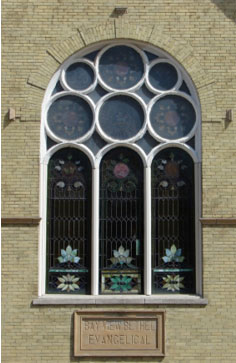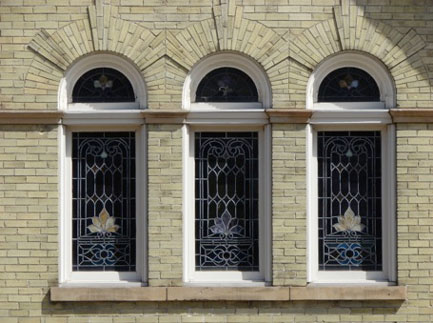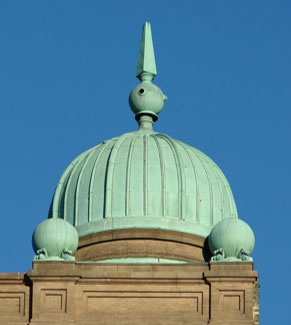55. Bethel Evangelical, 1897
Now Iglesia Hispana Adventista del Septimo Dia
(Spanish Seventh Day Adventist Church)
2392 South Woodward Street (at East Conway Street)
Architects: Crane and Barkhausen
Bethel Evangelical Church in the Bay View neighborhood was founded in 1883 as a mission church of Salem Evangelical, then located at Washington and 11th Streets on the South Side. (The 1874 church at Washington and 11th is still standing, and is now home to St. Michael’s Ukrainian Catholic Church.) The new mission, Bethel Evangelical, initially held services in a small wooden chapel built on the site of the present church. At that time, Bay View was a separate village, annexed to the City of Milwaukee in 1887.
In 1886, the mission incorporated as a self-sustaining congregation of the Evangelical Association, a denomination founded in 1800 in Pennsylvania and comprised mainly of German immigrants and their descendants. After worshiping in the small chapel for almost a decade and a half, the congregation began construction of the present brick church in 1897. Like many of the city’s other German-speaking congregations, the gradual conversion of services from German to English began shortly after World War I.
Architects Charles Crane (1850-1928) and Carl Barkhausen (1860-1934) both apprenticed in the office of Edward Townsend Mix, Milwaukee’s most prominent architect of the late nineteenth century. The two men formed a partnership in 1888, when Mix relocated his office to Minneapolis, and practiced together in Milwaukee until 1900.
Crane and Barkhausen designed many residences and other types of buildings, including several industrial and warehouse buildings in the city’s Third Ward. In addition to Bethel Evangelical, the firm designed Highland Avenue Methodist Church at Highland and 21st Street, a Gothic Revival building constructed in 1891. As a sole practitioner, Barkhausen later designed the Second Christian Science Church, built in 1913 on Highland Avenue near 27th Street.
Bethel Evangelical is a Cream City brick church of modest size that does not clearly fit into any of the common architectural style categories of the late nineteenth century. It has no features associated with the classical tradition, and the round-arch windows rule out the Gothic Revival. With its L-shaped form and entrances on the long side, the building differs from the common layout of Romanesque Revival churches. There is a corbeled arcade of brick at the top of the tower walls, but this feature and the round arches are not exclusive to the Romanesque Revival style. The building lacks the decorative details and mixing of exterior materials that are common to the Queen Anne style. The most appropriate label might simply be Victorian, a general term that refers more to a time period rather than a particular set of architectural characteristics.
A narrow spire of unusual shape rises from the hipped roof of the tower. No other church in Milwaukee has a spire of quite this shape. The spire resembles the spikes atop the copper domes of the Germania Building, an eight-story office building at Second and Wells Streets downtown. The Germania Building, designed by the firm of Schnetzky and Liebert, was built just prior to Bethel Evangelical Church, and may have influenced Crane and Barkhausen in their design of the church spire.
The church was known as Bethel Evangelical or Bay View Bethel Evangelical until just after World War II. In 1946, the Evangelical Association merged with the United Brethren Church, and thereafter the congregation used the lengthy name Bay View Bethel Evangelical United Brethren Church. In the late 1960s, the Evangelical United Brethren denomination merged with the Methodist Church. The Bay View congregation joined the existing Methodist church in the same neighborhood, about one-half mile to the south on Kinnickinnic Avenue, and sold their church building to a congregation of the Assembly of God. The Bay View Assembly of God occupied the building from the late 1960s into the present century. The church is currently used by its third owners, a Spanish-speaking congregation of the Seventh Day Adventist Church.
Sources:
“Dedicated a Church,” Milwaukee Sentinel, November 15, 1897, page 3, column 3.
Historic Designation Study Report: Bethel Evangelical Church (Bay View Assembly of God). City of Milwaukee, Department of City Development, 2001.



